数据结构之队列(Queue)
目录
1.队列(Queue)之概念
定义:队列是一种特殊的线性表,它只允许在一端进行插入(队尾)数据操作,在另一端进行删除(队头)数据操作。
队列具有先进先出的特点
队列的实现也是有两种方式
数组实现,链表实现
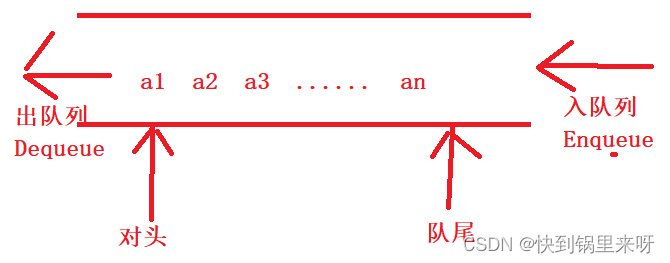
2.队列(Queue)之模拟实现
以单链表实现,并且做一点改动

先写一个上面这样结构的单链表
static class Node {
public int val;
public Node next;
public Node(int val) {
this.val = val;
}
}
public Node head;//队列头
public Node tail;//队列尾(1)入队offer()
public void offer(int val) {
Node node = new Node(val);
if (head == null) {
head = node;
tail = node;
}else {
tail.next = node;
tail = tail.next;
}
}(2)出队poll()
public int poll() {
if(head == null) {
return -1;
}
int oldVal = head.val;
if (head.next == null) {
head = tail = null;
}else {
head = head.next;
}
return oldVal;
}(3)查看当前对头元素peek()
public int peek() {
if(head == null) {
return -1;
}
return head.val;
}3.队列(Queue)之使用

public static void main(String[] args) {
java.util.Queue<Integer> queue = new LinkedList<>();
queue.offer(1);
queue.offer(5);
queue.offer(7);
queue.offer(45);
System.out.println(queue.size());
System.out.println(queue.peek());
queue.poll();
System.out.println(queue.poll());
}
4.队列(Queue)之循环队列
先看顺序队列中元素的入队出队操作,因为队列元素出队是在对头,
那也就是,队列中所有元素的移动都是在向前移动,而这样向前移动就会出现这样的问题
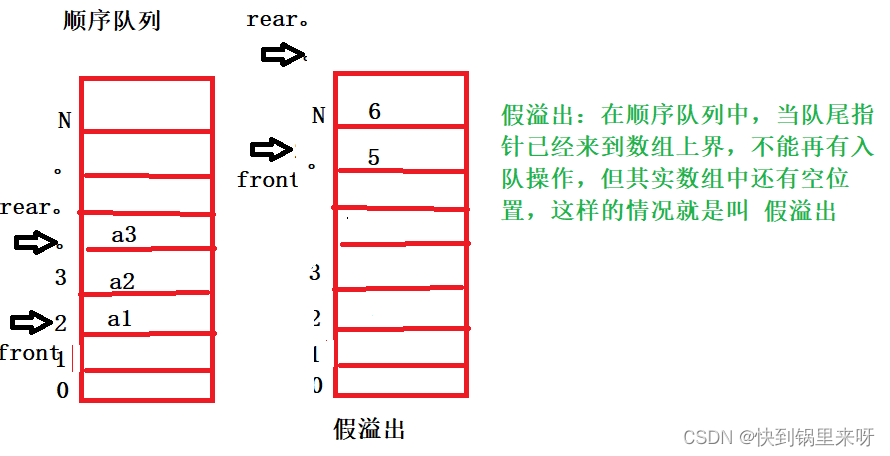
所以,相对来说 对于队列最好的方法是使用链表实现,否则就会造成假溢出
那么java中对于假溢出解决的办法是使用循环队列
正常情况下,顺序队列中会发生假溢出,也就是开辟的数组空间还有剩余空间,却因为rear越界表现为溢出,
使用循环队列,就是将队列的首尾相连,这样rear移动到LENGTH时,就会再从0开始循环
1. 那么如何区分队列的空与满 因为当rear== front时,既表示空又表示满
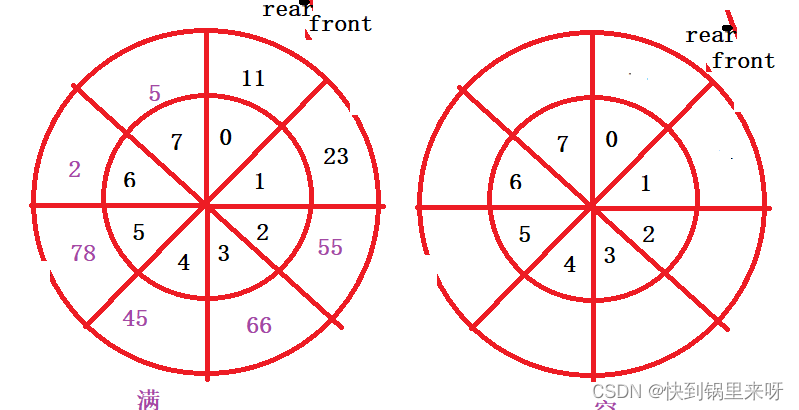
(1)最直接的方法就是计数
(2)牺牲一个存储空间 front前面不存数据,当rear在front前面的时候就是满了(尾在头前就是满了)
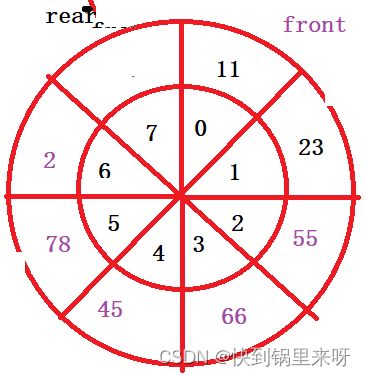

(3) 是设置一个标志变量flag,当front == rear,且flag = 0时为队列空,当front == rear,且flag= 1时为队列满
看一个练习题
题目要求  分析一下
分析一下
入队和出队除了要考虑队满和队空的条件,还要考虑,当这一圈转完,到下一圈,不能时不能只加加,还要模个数组长度,得出第二圈的下标
上代码
class MyCircularQueue {
public int[] elem;
public int front;//队头下标
public int rear;//队尾下标
public MyCircularQueue(int k) {
this.elem = new int[k+1];
}
//入队
public boolean enQueue(int value) {
if (isFull()) {
return false;
}
this.elem[rear] = value;
rear = (rear+1) % elem.length;
return true;
}
//出队
public boolean deQueue() {
if (isEmpty()) {
return false;
}
front = (front+1) % elem.length;//如果是K到0那就要%
return true;
}
//从队首获取元素
public int Front() {
if (isEmpty()) {
return -1;
}
return elem[front];
}
//获取队尾元素
public int Rear() {
if (isEmpty()) {
return -1;
}
int index = (rear == 0) ? elem.length-1 : rear-1;
return elem[index];
}
public boolean isEmpty() {
return rear == front;
}
public boolean isFull() {
return (rear+1) % elem.length == front;
}
}
5.队列(Queue)之双端队列(Deque)
双端队列(Deque)是指在两端都可以进行入队和出队的操作的队列
不过需要注意的是,不能将一个数据,在一端进行入队和出队操作,不然这样就成了栈
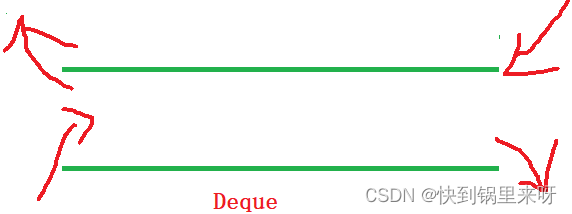
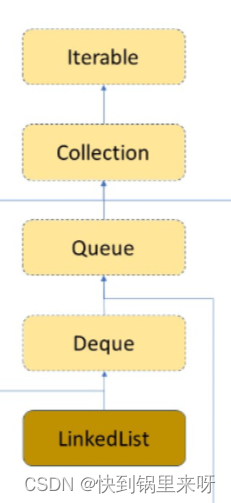
Deque是一个接口,使用时必须要创建LinkedList的对象
Deque<Integer> myQueue2 = new LinkedList<>();6.力扣中的练习题
6.1 用队列实现栈
题目要求
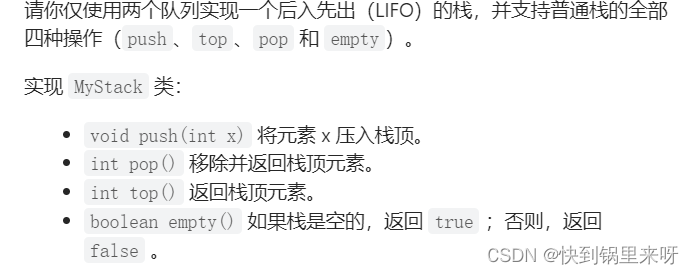
分析一下

上代码
class MyStack {
Queue<Integer> qu1;
Queue<Integer> qu2;
public int usedSize;
public MyStack() {
qu1 = new LinkedList<>();
qu2 = new LinkedList<>();
}
public void push(int x) {
if(!qu1.isEmpty()) {
qu1.offer(x);
} else if(!qu2.isEmpty()) {
qu2.offer(x);
} else {
qu1.offer(x);
}
usedSize++;
}
public int pop() {
if(empty()) {
return -1;
}
if(!qu1.isEmpty()) {
int curSize = qu1.size();
for(int i = 0; i < curSize-1; i++) {
qu2.offer(qu1.poll());
}
usedSize--;
return qu1.poll();
}else {
int curSize = qu2.size();
for(int i = 0; i < curSize-1; i++) {
qu1.offer(qu2.poll());
}
usedSize--;
return qu2.poll();
}
}
public int top() {
if(empty()) {
return -1;
}
if(!qu1.isEmpty()) {
int curSize = qu1.size();
int ret = -1;
for(int i = 0; i < curSize; i++) {
ret = qu1.poll();
qu2.offer(ret);
}
return ret;
}else {
int curSize = qu2.size();
int ret = -1;
for(int i = 0; i < curSize; i++) {
ret = qu2.poll();
qu1.offer(ret);
}
return ret;
}
}
public boolean empty() {
return usedSize == 0;
}
}
6.2 用栈实现队列
题目要求
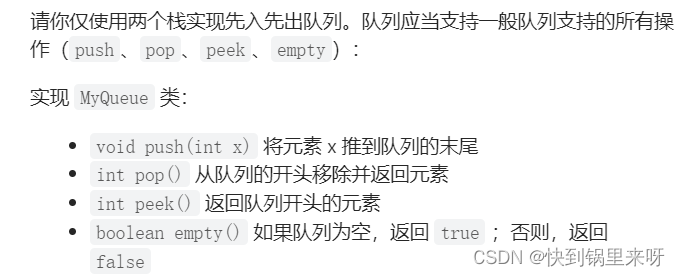
分析一下

上代码
class MyQueue {
Stack<Integer> s1;
Stack<Integer> s2;
public MyQueue() {
s1 = new Stack<>();
s2 = new Stack<>();
}
public void push(int x) {
s1.push(x);
}
public int pop() {
if(empty()) {
return -1;
}
if(s2.empty()) {
//将s1中所有元素倒过来
while(!s1.empty()) {
s2.push(s1.pop());
}
}
return s2.pop();
}
public int peek() {
if(empty()) {
return -1;
}
if(s2.empty()) {
//将s1中所有元素倒过来
while(!s1.empty()) {
s2.push(s1.pop());
}
}
return s2.peek();
}
public boolean empty() {
return s1.empty() && s2.empty();
}
}6.3 最小栈
题目要求

分析一下

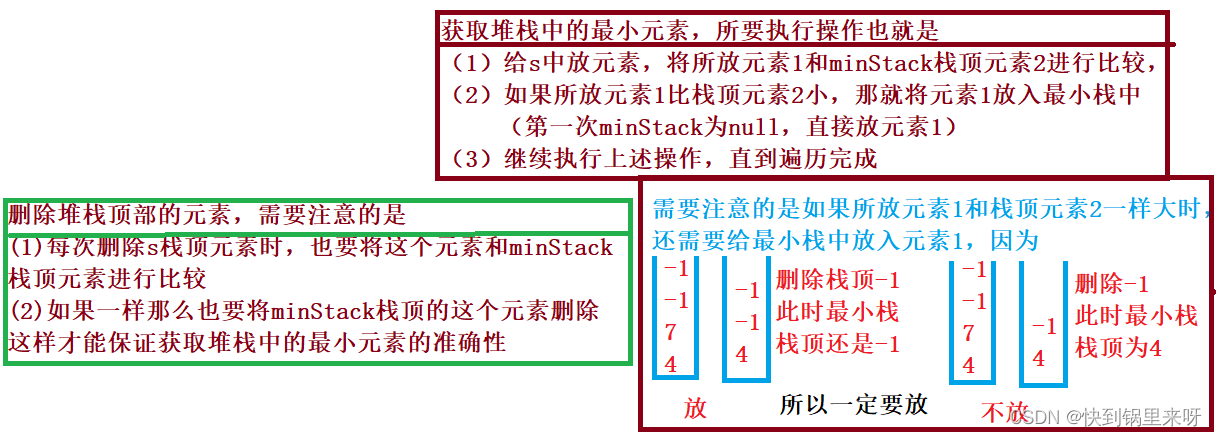 上代码
上代码
class MinStack {
private Stack<Integer> s;//普通栈
private Stack<Integer> minStack;//最小栈
public MinStack() {
s = new Stack<>();
minStack = new Stack<>();
}
public void push(int val) {
s.push(val);
if(minStack.empty()) {
//最小栈为null,直接放
minStack.push(val);
}else {
int peekV = minStack.peek();
if(val <= peekV) {
minStack.push(val);
}
}
}
public void pop() {
int popV = s.pop();
int peekVMinS = minStack.peek();
if(popV == peekVMinS) {
minStack.pop();
}
}
public int top() {
return s.peek();
}
public int getMin() {
return minStack.peek();
}
}
相关文章
- POJ 2051 Argus 优先队列
- 消息队列选型分析
- 【C/C++学院】0802-链式栈/链表队列以及优先队列/封装链表库
- 数据结构与算法JavaScript (二) 队列
- 数据结构复习之用两个栈模拟队列操作
- 第二百九十二节,RabbitMQ多设备消息队列-Python开发
- 栈和队列题目汇总
- 数据结构和算法-数据结构-线性结构-栈和队列
- (剑指Offer)面试题7:用两个栈实现队列
- 【学习总结】《大话数据结构》- 第4章-栈与队列
- 重新整理数据结构与算法——数组模拟队列和环形队列[三]
- 【python cookbook】【数据结构与算法】5.实现优先级队列
- 并发无锁队列学习之一【开篇】
- 数据结构与算法之美-3 栈队列递归 [MD]
- 数据结构和算法-数据结构-线性结构-栈和队列
- 【学习总结】《大话数据结构》- 第4章-栈与队列
- 重新整理数据结构与算法——单双链表模拟队列[四]
- 【python cookbook】【数据结构与算法】5.实现优先级队列
- Java 实例 - 队列(Queue)用法
- GaussDB(DWS)中共享消息队列实现的三大功能
- 【干货贴】消息队列如何利用标签实现消息过滤
- 野生前端的数据结构基础练习(2)——队列
- 【Linux 内核】CFS 调度器 ⑥ ( CFS 调度器就绪队列 cfs_rq | Linux 内核调度实体 sched_entity | “ 红黑树 “ 数据结构 rb_root_cached )
- 【Android 内存优化】Bitmap 内存缓存 ( Bitmap 内存复用 | 弱引用 | 引用队列 | 针对不同 Android 版本开发不同的 Bitmap 复用策略 | 工具类代码 )
- Java并发编程:阻塞队列
- 分布式之消息队列复习精讲
- 删除rabbitmq中持久化的队列和数据
- 使用rabbitmq消息队列
- 【RabbitMQ笔记05】消息队列RabbitMQ七种模式之Routing路由键模式
- 数据结构期末考试题库——栈与队列
- 【数据结构与算法】线性表--栈和队列(Stack & Queue)【详解】
- 数据结构和算法 四、队列
- (21)Blender源码分析之鼠标按下消息添加到队列的过程

